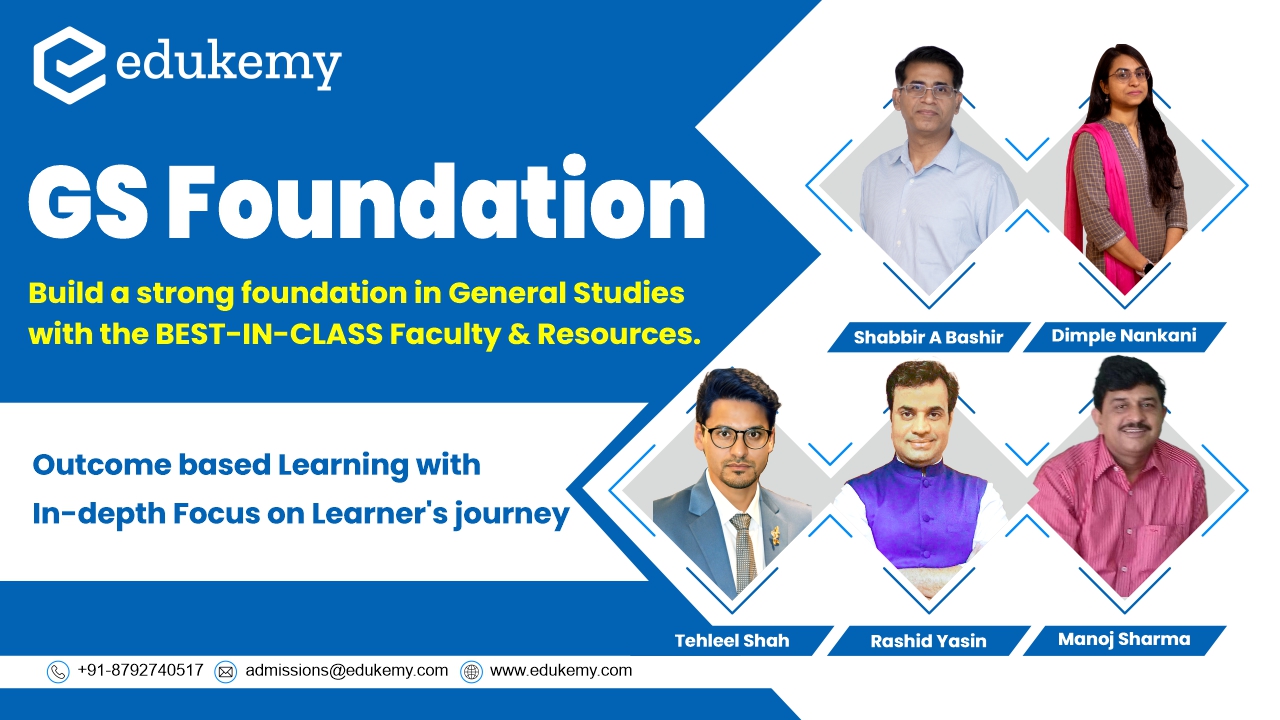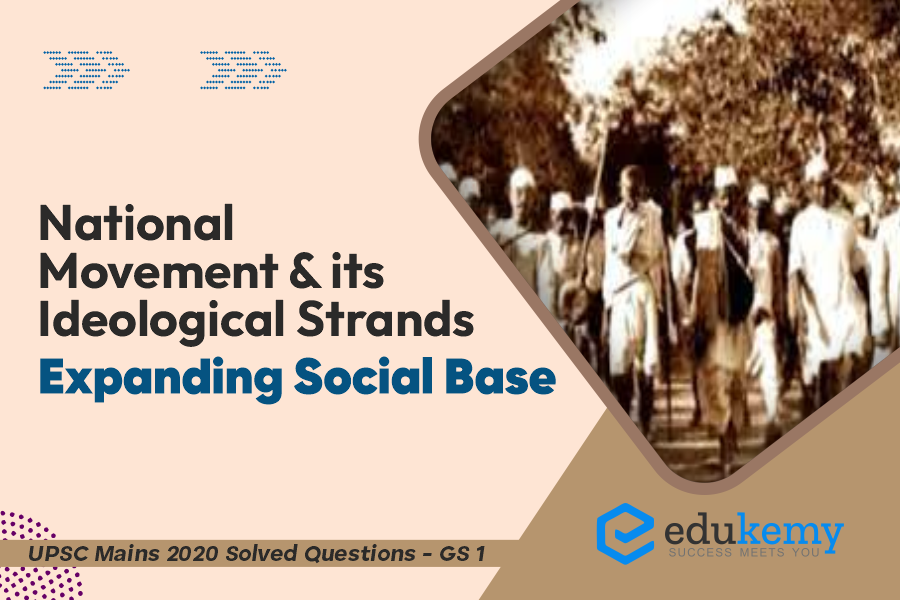Since the 1920s, the national movement has undergone a transformative evolution, branching out into diverse ideological strands that have significantly broadened its social base. This pivotal decade marked a period of intellectual ferment and political awakening, as different visions and philosophies emerged within the overarching framework of the national struggle. The movement, which initially coalesced around a common goal of independence from colonial rule, saw the infusion of ideologies ranging from Gandhian non-violence to more radical and socialist perspectives. This ideological diversity not only enriched the discourse within the movement but also attracted a wider spectrum of society, including peasants, workers, intellectuals, and women. The 1920s thus witnessed a dynamic expansion of the national movement, characterized by a pluralistic tapestry of ideas and a more inclusive participation from various segments of the population.
UPSC Mains General Studies Paper – 1 Mains 2020
The Freedom Struggle- Its various stages and important contributors/contributions from different parts of the country.
UPSC Mains Civil Services IAS Exam Question Paper – 2020
Contents
- 1 Structure of the Question
- 2 Answer
- 3 Conclusion
- 4 Frequently Asked Questions (FAQs)
- 4.1 1. What were the key ideological strands that emerged within the national movement in the 1920s?
- 4.2 2. How did Mahatma Gandhi’s philosophy influence the national movement during this period?
- 4.3 3. In what ways did the national movement expand its social base in the 1920s?
- 4.4 4. How did the demand for complete independence gain momentum during this period?
- 4.5 5. Were there any challenges faced by the national movement in the 1920s due to its diverse ideological strands?
- 5 In case you still have your doubts, contact us on 9811333901.
Structure of the Question
- In Introduction,
- Cite briefly how movements were different from post-1920’s – different ideological strands.
- In Body,
- Elaborate new ideologies and mass penetration.
- Discuss about Marxist ideology, RSS and CPI emergence, participation of labor class, peasantry, women, and backward classes to attest the expanding social base.
- Conclude by comparing the earlier social base and change in the ideology of Indian National Congress.
Answer
Introduction
Indian Freedom Movement which initially signified disorganization and irregular protests, after its expansion and addition of different ideological strands took the form of a structure with different ideological bodies competing and complementing each other in the process to achieve ultimate goal of freedom .The events and changes which manifested in the decade were seminal as they remarkably changed the course of the freedom struggle.
Ideologies that influenced freedom struggle
Revolutionary Nationalism
- The revolutionaries wanted complete independence and envisioned the State as what it would be after freedom.
- They put in great efforts to mobilise students, workers and peasants to be the driving force behind a mass struggle with a specific endeavour.
- Funds were raised through different ventures, for instance, the Kakori train robbery.
- Bhagat Singh’s Punjab Naujawan Sabha, Sachin Sanyal and Jogesh Chandra Chatterji stirred up the youth.
Communism
The working class participated in the movement with a definite intention to realize social equality.
- MN Roy was the driving force behind the ideology which attracted many Indian intellectuals and thus Communist party of India was founded in 1925.
- It brought the Freedom struggle to the International Arena and garnered the support of world Organizations.

Communalism
Post-1922, communalism reared its ugly head and the country was repeatedly plunged into communal riots. Old communal organizations were revived and fresh ones were founded. The Muslim League and Hindu Mahasabha began to further their vested interests.
The Labour Ideology
- People belonging to this ideology participated in the Non-Cooperation movement through the Cotton Mill workers strike in Bombay during 1919 and 1920.
- The legalization of labour unions by the Indian Trade Union Act in 1926 gave thrust to their activity.
- The Labour strike during the Civil Disobedience Movement and strike of Great Indian Peninsular Railway in 1930 was a major blow to the British.
Feminism
- Women participation has been improved with Gandhian methods and organizations like All Indian Women’s association came to the popular front.
- Active participation was seen in Non-cooperation and civil disobedience.
Revolutionary Activism
The failure of peaceful mediums had frustrated the youth. They began to mobilise with secret organisationslikeHindustan Republican Association (1923) andHindustan Socialist Republican Association (1928). RamPrasad Bismil, Ashfaqull Khan, Chandrashekhar Azad, Bhagat Singh among others actively engaged in anti-colonial activities and encouraged youth to join the cause.
Peasant Movements
- Between 1920 and 1940, peasant organizations arose.
- The first organization to be founded was the Bihar Provincial Kisan Sabha (1929) and in 1936 the All-India Kisan Sabha.
- The peasants organized by the Sabha demanded freedom from economic exploitation for peasants, workers, and all other exploited classes.
- At the time of Independence, the two most classical cases of peasant movements, namely the Tebhaga movement (1946-47) and the Telangana movement (1946-51).
Expansion of Social Base
Gandhiji for the first time made the national movement a mass movement. People from every background began to participate in the protests. Peasants (Eka movement), tribal (Alluri Sitaram Raju) vigorously engaged in challenging the authority of British rule. Due to this new awakening, the suppressed social classes asserted their right in society. Movements like Vaikom Satyagraha of Kerala (1924), Adi-dharma movement of Punjab (1926) were the outcome of the aspirations of the suppressed and Dalits.
Conclusion
Earlier, the freedom struggle, with a narrow social base, was largely confined to the middle-class and elites. The 1920s witnessed the expansion of the social base and people from every stratum began to associate themselves with it through different ideological dimensions. The participation of masses made the struggle more vibrant and inclusive.
Frequently Asked Questions (FAQs)
1. What were the key ideological strands that emerged within the national movement in the 1920s?
Answer: The national movement in the 1920s saw the emergence of various ideological strands, including Gandhian principles of non-violence and civil disobedience, socialist ideals advocating for economic equality, and the demand for complete independence from British colonial rule. These diverse ideologies contributed to a more comprehensive and inclusive social base for the movement.
2. How did Mahatma Gandhi’s philosophy influence the national movement during this period?
Answer: Mahatma Gandhi’s philosophy played a pivotal role in shaping the national movement. His emphasis on non-violence, satyagraha (civil disobedience), and the idea of Swaraj (self-rule) resonated widely, attracting people from different social strata. This philosophy not only provided a unifying force but also expanded the participation in the movement beyond traditional political boundaries.
Answer: The national movement broadened its social base by reaching out to various sections of society. It actively incorporated peasants, workers, women, and students into its fold. This inclusivity was facilitated by the adoption of different ideological approaches that addressed the diverse concerns and aspirations of these groups, making the movement more representative and reflective of India’s socio-economic diversity.
4. How did the demand for complete independence gain momentum during this period?
Answer: The 1920s witnessed a shift in the national movement’s goals towards complete independence. Influenced by leaders like Subhas Chandra Bose and the rising discontent against British policies, the demand for Purna Swaraj (complete independence) gained momentum. This ideological shift played a crucial role in uniting various factions within the movement and consolidating efforts toward a common goal.
5. Were there any challenges faced by the national movement in the 1920s due to its diverse ideological strands?
Answer: While the diverse ideological strands enriched the national movement, they also posed challenges in terms of coordination and a unified strategy. Differences in approaches and priorities sometimes led to internal tensions. However, the movement’s ability to navigate and reconcile these differences ultimately contributed to its strength and resilience, showcasing the adaptability and dynamism of the evolving Indian national struggle during this period.

In case you still have your doubts, contact us on 9811333901.
For UPSC Prelims Resources, Click here
For Daily Updates and Study Material:
Join our Telegram Channel – Edukemy for IAS
- 1. Learn through Videos – here
- 2. Be Exam Ready by Practicing Daily MCQs – here
- 3. Daily Newsletter – Get all your Current Affairs Covered – here
- 4. Mains Answer Writing Practice – here


